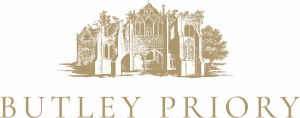JULY NEWS
Our very own Dig and developments
Another vibrant month with weddings, staycations, a wedding at the farmhouse, our first, using the thatched summerhouse. Gunilla Hailes (Together Flowers) from Iken festooned it with beautiful summer flowers, it looked rustic and charming. Isla and Matt tied the knot and Marshall their two-year old son, when not distracted by his tiny set of golf clubs, was the ring bearer.
We are planning to develop the farm buildings, which lie unused, for our wedding business. We hope to create a stunning wedding venue in the 12th century former refectory barn where the monks would have eaten at long trestle tables, mostly in silence, for over 300 years.
Butley Abbey farmhouse is built on the site of a former Augustinian Abbey, founded in 1171. In the 1320s it was the second wealthiest monastic house in East Anglia. It was built on the main route between Ipswich and Orford castle to provide bed and breakfast for important travellers, hospitality and alms. A community of 36 canons (ordained priests rather than monks) lived here and trained young priests to go out into the community.
A wall once surrounded the Abbey and its buildings covering 20 acres. All that remains of the Abbey is the Priory Gatehouse, now a wedding venue, a solitary magnificent stone arch covered in ivy and two handsome barns, now inhabited by pigeons, and some modern disused farm buildings. Up until the 1970s it was a bustling farmyard with pigs and venerable Suffolk Punches. The Suffolk Punch Trust incidentally is just up the road at Hollesley with an excellent visitor centre.
The Abbey was a substantial complex with the central cruciform church, cloisters, dormitories, chapter house, common room, library, cellars, storage areas and kitchens. There were administration offices, servant’s accommodation, a school, an infirmary for the sick, and a burial ground. The monks were entirely self sufficient, with vineyards, hops for beer, orchards and fishponds (which still survive) filled with carp, fields with cattle, sheep and pigs. A bake house, brew house, dairy, poultry house, dovecote, stables and barns for the livestock. There was a latrine and lavatorium block. A water mill ground corn, cloth making workshops and a dye house.
In 1537 Henry VIII dissolved the Priory during the English Reformation. Over the centuries the old buildings and the large church were gradually taken apart and reused by local people. Suffolk has almost no natural stone of its own, and most of the Priory buildings were built of stone brought on barges across the sea from Caen in Normandy. Unsurprisingly, the abandoned Priory became a sort of quarry, the stones melting away into the local community. On the B1078 between Tunstall and Rendlesham, for example, another stone arch can be seen, sold off and carried away centuries ago.
After the dissolution of the monasteries during the Reformation in 1538 the Priory estate passed from the Crown to the Duke of Suffolk, who married Mary Tudor, sister of Henry VIII. She was a regular visitor, and is recorded as enjoying summer picnics in the gardens of the Gatehouse. The Priory was sold on to a wealthy merchant from Hadleigh, William Forthe. He extended the Gatehouse and built himself a comfortable country house attached to it. It remained in the Forthe family until 1684, and then passed through number of other hands. It was used as the local vicarage in the 19th century and then finally bought, in a sorry state, by Dr Monty Rendall in 1926. Dr Rendall was the retired Headmaster of Winchester College, and he sank all his money into restoring it, very beautifully, living there till the end of his long life in 1951. He also oversaw an extensive archaeological dig among the foundations of all the old Priory buildings and established the layout of the whole institution. The Greenwell family bought it from him in 1932, and various families lived there until it became a wedding venue in the 1980s.
A family story relates that the late Lady Greenwell much disliked one of the tenants, who had forbidden her from darkening their doors. She disguised herself with a wig and eccentric attire and anonymously joined an historical group who were being given a tour of the Priory. She afterwards wrote an effusive thank you letter.
New archaeological work is about to start at Butley, and will doubtless turn up plenty more of historic interest.








